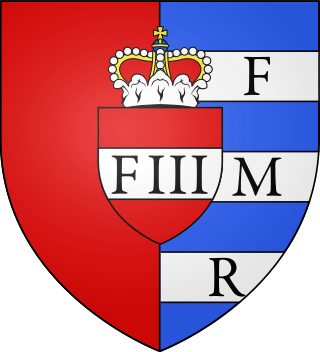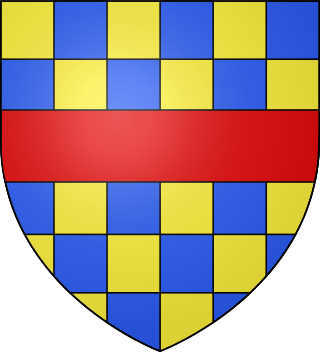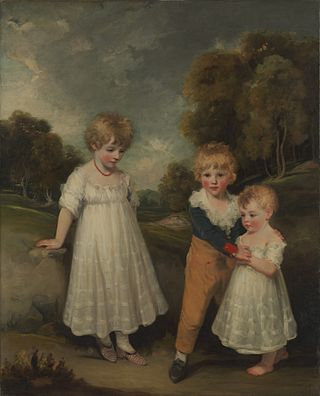
Duke of Newcastle upon Tyne was a title that was created three times, once in the Peerage of England and twice in the Peerage of Great Britain. The first grant of the title was made in 1665 to William Cavendish, 1st Marquess of Newcastle upon Tyne. He was a prominent Royalist commander during the Civil War.

Duke of Sutherland is a title in the Peerage of the United Kingdom which was created by William IV in 1833 for George Leveson-Gower, 2nd Marquess of Stafford. A series of marriages to heiresses by members of the Leveson-Gower family made the dukes of Sutherland one of the richest landowning families in the United Kingdom. The title remained in the Leveson-Gower family until the death of the 5th Duke of Sutherland in 1963, when it passed to the 5th Earl of Ellesmere from the Egerton family.

Baron de Ros of Helmsley is the premier baron in the Peerage of England, created in 1288/89 for William de Ros, with precedence to 24 December 1264. Premier baron is a designation and status awarded to the holder of the most ancient extant barony of the Peerage of England. Before the Dissolution of the Monasteries the Prior of the Order of St John in England was deemed the premier baron.

Baron Hastings is a title that has been created three times. The first creation was in the Peerage of England in 1290, and is extant. The second creation was in the Peerage of England in 1299, and became extinct on the death of the first holder in c. 1314. The third creation was in the Peerage of England in 1461, and has been in abeyance since 1960.

Baron de Clifford is a title in the Peerage of England. It was created in 1299 for Robert de Clifford (c.1274–1314), feudal baron of Clifford in Herefordshire, feudal baron of Skipton in Yorkshire and feudal baron of Appleby in Westmoreland. The title was created by writ, which means that it can descend through both male and female lines. The Norman family which later took the name de Clifford settled in England after the Norman Conquest of 1066 and was first seated in England at Clifford Castle in Herefordshire. The first Baron served as Earl Marshal of England but was killed at the Battle of Bannockburn in 1314. His 8th generation descendant the 11th Baron, was created Earl of Cumberland in 1525, whose grandson the 3rd Earl was a noted naval commander. On the latter's death in 1605, the earldom passed to his younger brother, the 4th Earl.

Baron Willoughby de Eresby is a title in the Peerage of England. It was created in 1313 for Robert de Willoughby. Since 1983, the title has been held by Jane Heathcote-Drummond-Willoughby, 28th Baroness Willoughby de Eresby.

Baron Strange is a title which has been created four times in the Peerage of England. Two creations, one in 1295 and another in 1326, had only one holder each, upon whose deaths they became extinct. Two of the creations, that of 1299 and that of 1628, are extant. The surname Le Strange was Latinized as Extraneus. The arms of Le Strange of Knockin Castle in Shropshire were: Gules, two lions passant argent.

Earl of Cromartie is a title that has been created twice, both for members of the Mackenzie family. It was first created as Earl of Cromarty in the Peerage of Scotland in 1703 for Sir George Mackenzie, 2nd Baronet, but his titles were forfeited after the Jacobite rising of 1745. It was recreated in 1861 in the Peerage of the United Kingdom for Anne Sutherland-Leveson-Gower, Duchess of Sutherland. Since 1979, the Earl of Cromartie has been chief of Clan Mackenzie.

Baron Seaford, of Seaford in the County of Sussex, is a title in the Peerage of the United Kingdom. It was created on 1 July 1826 for Charles Ellis, a Jamaican sugar planter and slave-owner who had earlier represented Heytesbury, Seaford and East Grinstead in the House of Commons. In 1798 he married the Hon. Elizabeth Catherine Caroline Hervey, daughter of John Hervey, Lord Hervey, eldest son of Frederick Augustus Hervey, 4th Earl of Bristol and 5th Baron Howard de Walden. In 1803 Lord Seaford's four-year-old son Charles Ellis inherited the barony of Howard de Walden from his great-grandfather and became the sixth Baron Howard de Walden. In 1845 he also succeeded his father as second Baron Seaford.

Baron Howard de Walden is a title in the Peerage of England. It was created by writ of summons in 1597 by Queen Elizabeth I for Admiral Lord Thomas Howard, a younger son of Thomas Howard, 4th Duke of Norfolk, by his second wife, the Honourable Margaret Audley, daughter of Thomas Audley, 1st Baron Audley of Walden.
John Leveson-Gower, 1st Baron Gower PC, styled Sir John Leverson-Gower, 5th Baronet, from 1691–1703, was an English peer and politician from the Leveson-Gower family. His four sons served in parliament.

Baron Clifford is a title in the Peerage of England created by writ of summons on 17 February 1628 for Henry Clifford, the heir of Francis Clifford, 4th Earl of Cumberland. Francis was believed to hold the Barony de Clifford, created in 1299, which could therefore be used to give Henry a seat in the House of Lords during his father's lifetime via a writ of acceleration. However, it would later be determined that the barony had in fact passed to his niece, Lady Anne Clifford. The summons of 1628 therefore unintentionally created a new barony, held by Henry. In 1641, on his father's death, Henry inherited the earldom of Cumberland, which became extinct upon his own death in 1643.
William George Cavendish, 2nd Baron Chesham was a British Liberal politician.

The titles Baron Montacute or Baron Montagu were created several times in the Peerage of England for members of the House of Montagu. The family name was Latinised to de Monte Acuto, meaning "from the sharp mountain"; the French form is an ancient spelling of mont aigu, with identical meaning.

Elizabeth Sackville-West, Countess De La Warr and 1st Baroness Buckhurst, was a British peeress.
Thomas Tufton, 6th Earl of Thanet, 18th Baron de Clifford PC was an English nobleman and politician.
The Ogle family were prominent landed gentry in Northumberland, England. The earliest appearances of the family name were written Hoggel, Oggehill, Ogille and Oghill.
Other Lewis Windsor, 4th Earl of Plymouth DL was a British peer, styled Lord Windsor until 1732.

Margaret Coke, Countess of Leicester, also suo jure19th Baroness de Clifford, was a British noblewoman and peeress.
Sir James Macdonald, 2nd Baronet, GCMG was a British politician. He sat in the House of Commons between 1805 and 1832.











